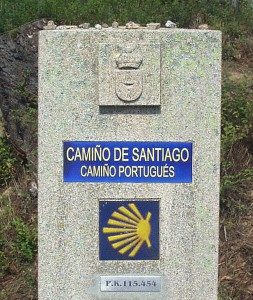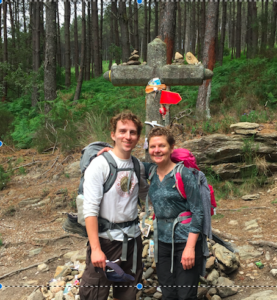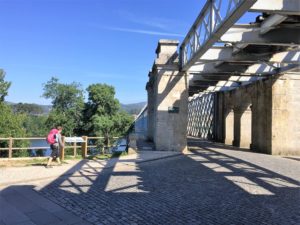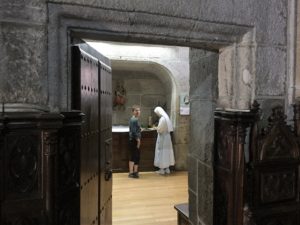Vague memories of the TV programme – Jeux sans Frontieres – spring to mind as I write. I don’t remember much about it, but, even as a child, the idea of not having borders, for anything, was appealing. Brexit also, unsurprisingly, springs to mind, that being ‘quite’ a topical issue. On that matter  all I will say right now is that the UK people’s decision to start a huge disentanglement process is undoubtedly a momentous one. Anyway, back to the Camino…
all I will say right now is that the UK people’s decision to start a huge disentanglement process is undoubtedly a momentous one. Anyway, back to the Camino…
I ended day three, as previously mentioned, with red legs salvaged by the generous spirit, and salve, of a fellow peregrino. That and a switch to trainers, rather than hiking boots, and my momentary lapse of courage had left me. So much so that Steve and I reduced the guidebook’s recommended next four days down to three. Now quite seasoned walkers, ninety kilometers was, we thought, perfectly doable.
And so day four began with us departing Ponte de Lima towards Rudiaes and to face ‘the steepest  accumulative climb’ up the Labruja valley to the 405m Alto de Portela Grande. Walking through beautiful pine forests the perfumes were quite intoxicating, the trees also providing some welcome shade after the heat of the previous days. Lots of time for reflection too, stopping at a makeshift pilgrim ‘shrine’, we added a few stones to the collection, our thoughts unspoken.
accumulative climb’ up the Labruja valley to the 405m Alto de Portela Grande. Walking through beautiful pine forests the perfumes were quite intoxicating, the trees also providing some welcome shade after the heat of the previous days. Lots of time for reflection too, stopping at a makeshift pilgrim ‘shrine’, we added a few stones to the collection, our thoughts unspoken.
From Rubiaes, the route goes on to Tui, which brings me back to why I was going on about borders… here we crossed the Rio Minho and, between one end of the bridge and the other we had migrated, effortlessly I must say, from Portugal to Spain. Suddenly time leapt ahead by one hour, the river became the Mino, bom became bon – though this was not assured, with the Galician, Galego and Castellano regional variants all to be encountered in turn. But, in reality, I felt, nothing really discernbly changed. And so we soldiered on.
though this was not assured, with the Galician, Galego and Castellano regional variants all to be encountered in turn. But, in reality, I felt, nothing really discernbly changed. And so we soldiered on.
By now we were quite familiar with a number of fellow walkers, mainly German and Dutch. We congregated for dinners and intermittently met each other on the way. Food, of course, was a key priority and we were rarely disappointed. I was pleasantly surprised that the Spanish hospitality usually included free tapas served with drinks and the drinks, as in Portugal, were usually a very palatable local vino.
 Our days often included visits to the plethora of churches and cathedrals that line the way. Like many British, baptised Christians but not remotely of the faithful, the atmosphere of these solid buildings was still appealing. At Redondela we visited the 15th century Iglesia de Santiago. A young nun, she looked to be in her twenties, called me over. In a self-assured way, appearing at peace with herself, she gave me her blessing and a small card, in memory of the church, her home. A poignant moment.
Our days often included visits to the plethora of churches and cathedrals that line the way. Like many British, baptised Christians but not remotely of the faithful, the atmosphere of these solid buildings was still appealing. At Redondela we visited the 15th century Iglesia de Santiago. A young nun, she looked to be in her twenties, called me over. In a self-assured way, appearing at peace with herself, she gave me her blessing and a small card, in memory of the church, her home. A poignant moment.
Three more days on the way had passed as we arrived after our longest day of 38km, much of it through eucalyptus woods, into Pontevedra, a regional capital and home to a population of 75,000. Life felt good.
If you enjoyed reading this article you might also enjoy The Nomad Inside out on the Camino Vilarinho to Barcelos Cameraderie on the Camino April First – West Highland Way


 RSS – Posts
RSS – Posts